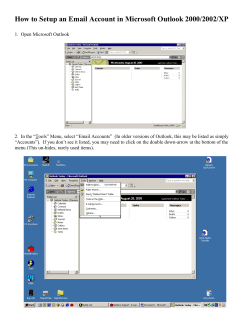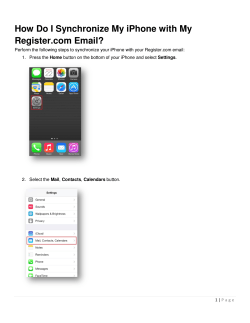
Mail Lab
Handout 13
CSCI 134: Spring, 2015
Lab 10
More Spam, Spam, Spam...
Objective. To gain experience with Streams. (This lab is due at the end of your lab session. It
is doable in three hours, and we’d like you to leave lab being able to concentrate on your
programming project. If you are not done by the end of lab, please talk to us before leaving.)
POP Mail Connections. This week’s assignment will give you the opportunity to practice working
with Streams by writing the networking part of the Spam Filter program. That is, you will complete
the MailConnection class, which was provided to you as a library last week. The class implements
the POP mail protocol by opening a socket and input and output streams, writing messages to the
server, and interpreting the responses.
Before getting into the details of MailConnection, let us quickly review the POP mail protocol.
What follows is an example session involving connecting to a mail server.
1
artint:˜/] telnet fuji.cs.williams.edu 110
Trying 137.165.8.7...
Connected to fuji.cs.williams.edu.
Escape character is ’ˆ]’.
+OK Dovecot ready. <11d6b.8.55438f47.CpOMUt1X9zPV3AYc9B6aKg==@fuji.cs.williams.edu> (*)
USER test134a
+OK
PASS ---------+OK Logged in.
STAT
+OK 4 8589
TOP 5 0
-ERR There’s no message 5.
TOP 3 0
+OK
Return-Path: <andrea@cs.williams.edu>
Delivered-To: test134a@fuji.cs.williams.edu
Received: from bull.cs.williams.edu (bull.cs.williams.edu [137.165.8.2])
by fuji.cs.williams.edu (Postfix) with ESMTPS id 565631FD0BAB
for <test134a@fuji.cs.williams.edu>; Tue, 21 Apr 2015 10:52:24 -0400 (EDT)
Received: from eringer.cs.williams.edu (eringer [137.165.8.3])
by bull.cs.williams.edu (8.14.7/8.14.7) with ESMTP id t3LEqKDW095937
for <test134a@fuji.cs.williams.edu>; Tue, 21 Apr 2015 10:52:23 -0400 (EDT)
... some received information omitted
Received: from artint.cs.williams.edu (artint.cs.williams.edu [137.165.8.78])
(authenticated bits=0)
by eringer.cs.williams.edu (8.14.7/8.14.5) with ESMTP id t3LEppaH078207
(version=TLSv1/SSLv3 cipher=AES128-SHA bits=128 verify=NO)
for <test134a@fuji.cs.williams.edu>; Tue, 21 Apr 2015 10:52:20 -0400 (EDT)
From: Andrea Danyluk <andrea@cs.williams.edu>
Subject: next lab
Message-Id: <EB3594DC-28F2-4EAE-A9A4-C3BC20DF48B1@cs.williams.edu>
Date: Tue, 21 Apr 2015 10:52:19 -0400
To: "test134a@fuji.cs.williams.edu" <test134a@fuji.cs.williams.edu>
Mime-Version: 1.0 (Mac OS X Mail 6.6 \(1510\))
X-Mailer: Apple Mail (2.1510)
... other received info omitted ...
X-Spam-Checker-Version: SpamAssassin 3.4.0 (2014-02-07) on bull.cs.williams.edu
.
QUIT
+OK Logging out.
Connection closed by foreign host.
Your MailConnection class will need to encode most of this protocol. We will give you implementations of the SpamFilter, Message and MessageList classes from last week.
See the handouts web page to obtain a copy of the starter code. POP email traffic includes
passwords sent as plain text that can be intercepted, so Purple air may filter it out for
security. It is best to develop this on one of the lab machines. If you use your laptop, you
should connect it to the wired network.
The Design
The MailConnection class manages the communication with a mail server. We begin with the
descriptions of the private methods we have provided in the class for your use:
2
private void netPrintln(String s): Writes a string to the mail server’s output stream.
private String netReadLine(): Reads a line from the mail server.
private void close(): Closes the socket. Must be called if the connection was not established in
the constructor.
Note: We have included a constant, DEBUG that is initially set to be true. It causes anything written
to the mail server by netPrintln to be echoed to the console window in BlueJ. Similarly, anything
read from the mail server by netReadLine is also echoed to the console window. It should be set to
false before you turn in your program.
We also provide two public methods: disconnect(), which closes the connection after a successful mail session, and isConnected(), which returns a boolean indicating whether the connection is
currently active with the mail server.
The following is a description of the constructor and methods that you must complete.
public MailConnection (String host, String userName, String password)
Create a mail connection to a host for a specific user. If everything works, set connected to true
and return. If it fails for any reason, pop up a dialog box with a helpful message and call the
close() method to close the connection
We have provided the code to create a new socket as well as input and output streams (called
input and output) that use that socket. You should read the response from the mail server
(using the private netReadLine() method) starting with the line marked (*) in the sample
above. If that line starts with “+OK” then go through the protocol identifying the USER and
password. If all of the responses start with “+OK” then set boolean variable connected to true.
Otherwise, pop up a dialog box providing information on what went wrong (see the provided
code).
public int getNumMsgs()
Returns the number of messages in the mailbox you are connected to. This returns 0 if there is
no active connection.
This method will send a STAT command to the server and extract the number of messages available from the line the server sends back. It will then return the integer obtained from that string.
Recall that the method Integer.parseInt(s) converts the digits in the String s to an integer
and returns that value. For example, Integer.parseInt("33") returns the value 33.
public String header (int msg)
Returns the headers of a mail message identified by the number passed in. Unlike Java, mailboxes number messages beginning with 1 and go up to the number of messages contained in the
mailbox. To obtain the header for message i, you must send “TOP i 0” to the mail server.
The header method returns an empty string if it is called when there is no connection or if the
msg parameter is less than 1 or greater than the actual number of messages.
This method should use readResponse() (see below) to obtain the string consisting of the full
header.
private String readResponse()
Reads a multi-line response from the mail server. Returns an empty string if there is no connection.
If the connection is alive then it should successively read new lines from the input stream and
concatenate them together (inserting newline characters at the end of lines) until the results of
a read are either null or “.”.
Be sure to test the constructor and each method you are writing carefully before going on to the
next one. To make this easy, the version of this week’s user interface, as implemented in the starter,
does not fetch and filter the mail all at once, as in last week’s lab. Instead, the first time you click
3
the button it merely connects to the server. The next time you click, it gets the number of available
messages. After that, each click downloads one message until they have all been fetched. Once your
program is working, you can change our program to behave more like last week’s lab by removing one
line in the begin method as indicated by the comments in our code.
Submitting Your Work
Once you have saved your work in BlueJ, please perform the following steps to submit your assignment:
• First, return to the Finder. You can do this by clicking on the smiling Macintosh icon in your
dock.
• From the “Go” menu at the top of the screen, select “Connect to Server...”.
• For the server address, type in “Guest@fuji” and click “Connect”.
• A selection box should appear. Select “Courses” and click “Ok”.
• You should now see a Finder window with a “cs134” folder. Open this folder .
• You should now see the drop-off folders for the three labs sections. As in the past, drag your
“Lab10MailConnection” folder into the appropriate lab section folder. When you do this, the Mac
will warn you that you will not be able to look at this folder. That is fine. Just click “OK”.
• Log off of the computer before you leave.
This lab is due at the end of your lab session. If you submit and later discover that your submission was flawed, you can submit again. We will grade the latest submission made before your lab
section’s deadline. The Mac will not let you submit again unless you change the name of your folder
slightly. It does this to prevent another student from accidentally overwriting one of your submissions.
Just add something to the folder name (like “v2”) and the resubmission will work fine.
Grading Guidelines
As always, we will evaluate your program for both style and correctness. Here are some specific
items to keep in mind and focus on while writing your program:
Style
Descriptive comments
Good names
Good use of constants
Appropriate formatting
Design
General correctness/design/efficiency issues
Conditionals and loops
Parameters, variables, and scoping
Good use of private methods
Good use of strings
Correctness
Constructor
getNumMessages
header
readResponse
4
© Copyright 2025









